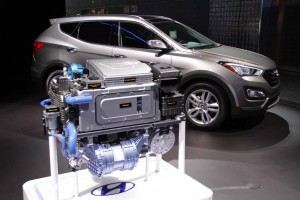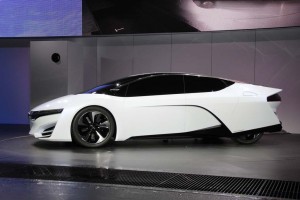With three different automakers announcing production plans for new fuel-cell vehicles at the L.A. Auto Show, hydrogen power is back in the headlines. But even with Honda’s global autos chief Tetsuo Iwamura calling the technology the “ultimate” solution in the search for clean mobility, not everyone is quite convinced.
With only a handful of fueling stations yet available – and plenty of questions left about how to even produce hydrogen efficiently — some skeptics argue that fuel cell technology remains, as the old adage goes, “the fuel of the future and always will be.”
Among the many skeptics is Elon Musk, the CEO of electric vehicle maker Tesla Motors, who recently asserted there is “no way” hydrogen can become a viable alternative to battery power, never mind the well-entrenched internal combustion engine. Fuel cells, he argued, are too complex, too costly and there’s a complete lack of a production and distribution network.

The Hyundai fuel cell stack shown in front of the Tucson. The entire package fits under the hood where a gas engine would normally go.
“Where’s the infrastructure? Who’s going to build it,” echoed Carlos Ghosn, CEO of Nissan Motor Co., during an appearance at the Tokyo Motor Show last week, where rival Toyota unveiled a prototype of the hydrogen fuel-cell vehicle it plans to put into production in 2015.
(Click Herefor more on Toyota’s fuel-cell vehicle plans.)
Toyota repeated that announcement in Los Angeles, where Honda and Hyundai also put battery car prototypes on display. Honda expects to have a production version of its FCEV fuel-cell concept ready for market in 2015, while Hyundai’s Tucson Fuel-Cell Vehicle will be rolling into showrooms by next spring, according to the Korean carmaker.
(Honda shows FCEV fuel-cell vehicle prototype. Click Here for a closer look.)
Fuel cell technology has been around since the 1830s, since the concept was developed by British chemist William Grove. But the first practical application only came in the 1970s, providing power for the Apollo moon capsules.
Fuel cells are simpler than Tesla CEO Musk might suggest. Hydrogen gas is pumped into a device known as a “stack,” passing through a permeable membrane coated with rare, catalytic metals – most commonly platinum. The lightweight gas combines with oxygen from the air, producing a flow of electric current and water vapor. That current can be used to power an electric vehicle’s motors, which is why proponents refer to fuel cells as “refillable batteries.”
(Hyundai hopes to fire up the hydrogen car market. Click Here to find out more.)
There have been significant breakthroughs in stack design in recent years. Honda’s latest version is about two-thirds the size of the stack used in the earlier FCX Clarity hydrogen car, making it small enough that the entire powertrain now can fit under the hood. Hyundai, meanwhile, says it has reduced the cost of its fuel-cell stack by 60% over just the last two years.
Still, not everyone is convinced the technology is ready for prime time, Ghosn saying in Tokyo that he “would be very curious and interested to see competitors who say they are going to mass market the car in 2015.”
While the basic technology to turn hydrogen into electric current may have reached the point of production, skeptics contend, that doesn’t mean the technology can move ahead.
(Honda Accord named “Green Car of the Year.” Click Herefor the full story.)
The reality is that there are currently no more than a dozen places to refuel a vehicle like the Honda FCX Clarity – of which there are about 100 running around on Southern California roads. The Golden State’s legislature recently passed a bill providing $20 million a year to expand that to about 100 pumps by decade’s end. And Hyundai Motor America CEO John Krafcik told TheDetroitBureau.com that the maker hopes that by committing to production it will help resolve the chicken-and-egg problem, giving motivation to energy companies to invest their own money in a refueling infrastructure.
But that’s not the only concern. While a fuel-cell vehicle, or FCV, might produce no onboard emissions, not everyone is convinced the technology is as clean as it seems. “We still have the problem that hydrogen mobility only makes sense if you use green energy,” cautioned Rudolf Krebs, head of Volkswagen AG’s electric propulsion program.
While hydrogen is the most abundant element in the universe, it is available only as part of more complex chemicals on Planet Earth. So, to produce the pure gas requires breaking down other compounds. One approach is to electrolyze water splitting it into two parts hydrogen, one part oxygen. But, like Krebs, many environmentalists say that approach is valid only if using renewable forms of electricity.
Another alternative is to crack fossil hydrocarbons, whether petroleum, coal, or most efficiently, natural gas. By that approach, hydrogen does create some emissions, but Hyundai’s data suggests that route produces a fraction of the CO2 of burning compressed natural gas in a conventional, internal combustion engine.
The debate is likely to continue, and it is far from certain hydrogen proponents can overcome the hurdles facing fuel-cell technology. But with battery power struggling with its own drawbacks, hydrogen just might find a place in the market in the years to come.

